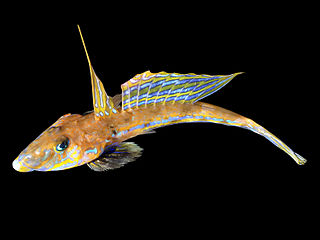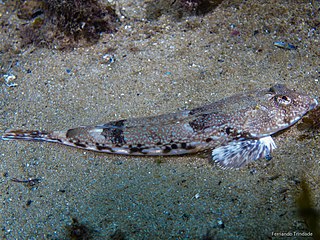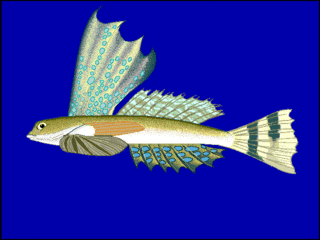
Dragonets are small, percomorph, marine fish of the diverse family Callionymidae found mainly in the tropical waters of the western Indo-Pacific. They are benthic organisms, spending most of their time near the sandy bottoms, at a depth of roughly two hundred meters. There exist 139 species of the fish, in nineteen genera.

Megalopyge opercularis is a moth of the family Megalopygidae. It has numerous common names, including southern flannel moth for its adult form, and puss caterpillar, asp, Italian asp, fire caterpillar, woolly slug, opossum bug, puss moth, tree asp, or asp caterpillar.

The Draconettidae, slope dragonets, are a small family of fish in the order Perciformes. They are found in temperate to tropical waters of the Atlantic, Indian and western Pacific Oceans. They are closely related to, and appear similar to, the fish of the Callionymidae. They are small fish, the largest species reaching 12 cm (4.7 in) long. Like the callionymids, they are bottom-dwelling fish, and usually sexually dimorphic.

Callionymus is a genus of dragonets found mostly in the Indian and Pacific oceans with a few species occurring in the Atlantic Ocean.

The starry dragonet is a species of dragonet native to the Indian Ocean where it is found at depths of around 40 metres (130 ft). It occasionally is found in the aquarium trade. It grows to a length of 7.5 centimetres (3.0 in) TL.

The ocellated dragonet or scooter dragonet is a species of tropical marine fish in the family Callionymidae. It is native to the southwest Pacific Ocean from southern Japan to the Marquesan Islands.

The lancer dragonet, Baird's dragonet, coral dragonet or St Helena dragonet, is a species of dragonet native to the warmer waters of the Atlantic Ocean where it occurs at depths of from 1 to 91 metres. In the western Atlantic it occurs from Cape Hatteras southwards along the east coast of North America. including Bermuda and the Bahamas, into the Gulf of Mexico and throughout the Caribbean Sea. It has also been recorded from Ilha da Trindade off Brazil. In the eastern Atlantic it has been recorded from the Cape Verde Islands, Ascension Island, St. Helena, and Sao Tome e Principe in the Gulf of Guinea. This species grows to a length of 11.4 centimetres (4.5 in) TL.

The delicate dragonet is a species of dragonet native to the Red Sea through the Indian Ocean to the western Pacific Ocean. It occurs at depths of from 1 to 20 metres. This species grows to a length of 6 centimetres (2.4 in) TL.
The longtail dragonet is a species of dragonet native to the western Indian Ocean. It can be found at depths of from 30 to 180 metres. This species grows to a length of 28 centimetres (11 in) TL. The specific name honours the British zoologist John Stanley Gardiner (1872–1946).
Callionymus hindsii, Hinds' dragonet, is a species of dragonet native to the Indian Ocean and the western Pacific Ocean where it occurs at depths down to 40 metres (130 ft). This species grows to a length of 9 centimetres (3.5 in) TL. The specific name is thought to most likely to be in honour of the British naval surgeon, naturalist and writer Richard Brinsley Hinds (1811-1846).
The spotted dragonet is a species of dragonet native to the eastern Atlantic Ocean and the Mediterranean Sea where it occurs at depths of from 45 to 650 metres. This species is important to local peoples engaged in subsistence fishing.

The reticulated dragonet is a species of dragonet native to the northeastern Atlantic Ocean and the Mediterranean Sea where it is found at depths of from 0 to 110 metres. This species grows to a length of 11 centimetres (4.3 in) TL. This species has a flattened head and body, the head has a triangular shape with the eyes placed on the top of the head. It has two dorsal fins with the first one being triangular in shape. It has blue spots along the flanks and four saddle-like markings on their backs which have sharply defined outlines. It is similar to the common dragonet but is distinguished by its smaller size and the sharply defined border around the saddle markings on the back.
The cheekspot blenny is a species of combtooth blenny found in the western Indian Ocean, in the Persian Gulf, Gulf of Oman and adjacent parts of the Indian Ocean. This species reaches a length of from 6 centimetres (2.4 in) TL.

The high-finned dragonet is a species of dragonet native to the Pacific Ocean off the coasts of northwestern Australia as well as New Caledonia, where it favors substrates consisting of sand or rubble and reaches a length of 15 centimetres (5.9 in) TL.
The Kai Island deepwater dragonet is a species of dragonet native to the Indian Ocean and the western Pacific Ocean, from Zanzibar and the coast of East Africa to the western Pacific Ocean including southern Japan, the East China Sea and the Banda Sea. It is the only species in the monotypic genus Bathycallionymus. This species was formally described in 1880 as Callionymus kaianus by the German-born British zoologist Albert Günther with from a type collected off Kai Island in the Banda Sea during the Challenger expedition of 1872–1876. Some authorities still place this fish in the genus Callionymus.
Repomucenus is a genus of dragonets native to the Indian Ocean and the western Pacific Ocean. This genus also includes one freshwater species (R. olidus).
The Pouch snake eel is an eel in the family Ophichthidae. It was described by George S. Myers and Charles Barkley Wade in 1941, originally under the genus Letharchus. It is a marine, tropical eel which is known from the eastern central and southeastern Pacific Ocean, including the Galapagos Islands, the Revillagigedo Islands, and the Cocos Islands. It is known to dwell at a maximum depth of 10 metres (33 ft), and inhabits sand sediments. Males can reach a maximum total length of 64.3 centimetres (25.3 in).

Neoniphon opercularis, the blackfin squirrelfish, also known as the mouth-fin squirrelfish or clearfin squirrelfish, is a species of squirrelfish found in the Indian Ocean and Pacific Ocean from East Africa as far east as New Caledonia. It lives alone or in small groups in or near reefs and lagoons between 3 and 25 metres deep and can reach sizes of up to 35.0 centimetres (13.8 in) TL. It eats crabs and shrimps. Its dorsal fin is raised to scare off or startle predators. It also has a large venomous spine at the corner of its preopercle. It is relatively unaffected by commercial fishing, but is sometimes used as bait for tuna fisheries.

Callionymiformes is an order of bony fish containing two families, the dragonets Callionymidae and the Draconettidae. In some taxonomies these families make up the suborder Callionymoidei of the wider grouping known as Perciformes, Nelson (2016) recognised the order but subsequent workers have suggested that if Callionymiformes is recognised as an order then the order Syngnathiformes is rendered paraphyletic and include Callionmyoidei within that taxon.

The rainfordia, also known as the flathead perch or Rainford's perch, is a species of marine ray-finned fish, related to the groupers and classified within the subfamily Epinephelinae of the family Serranidae. It is found in the eastern Indian Ocean and in the Western Pacific Ocean. It is the only species in its monotypic genus.












